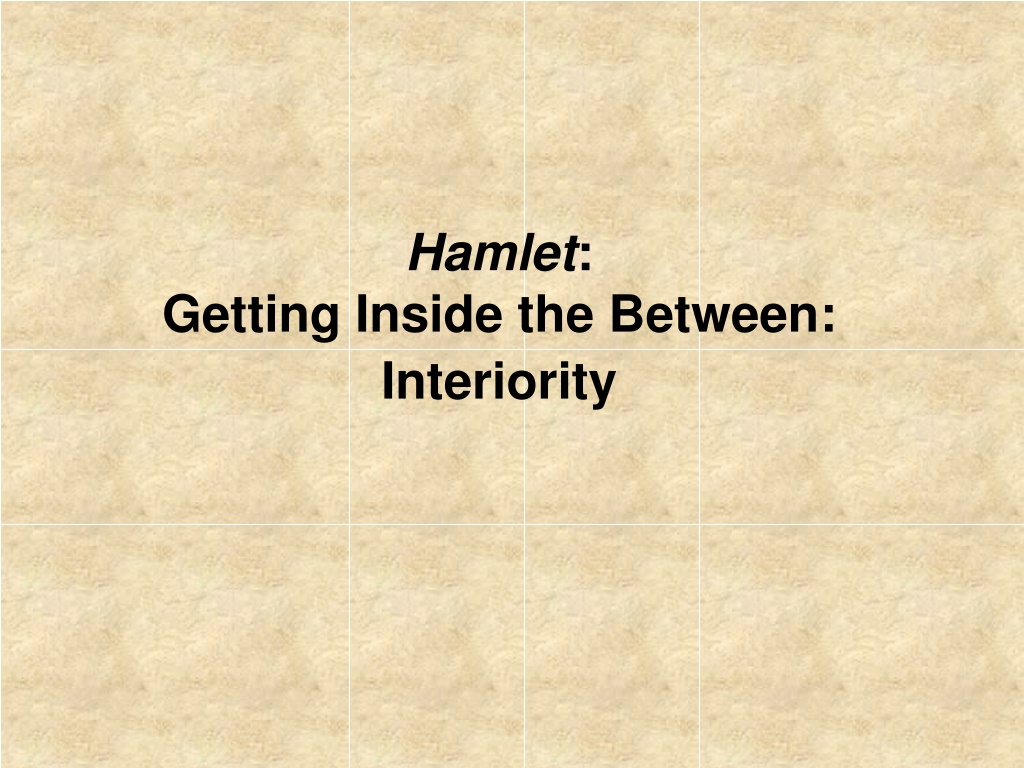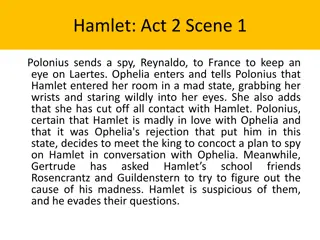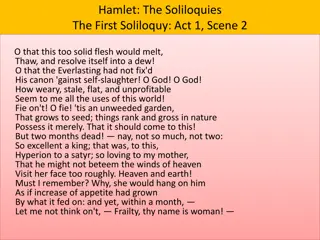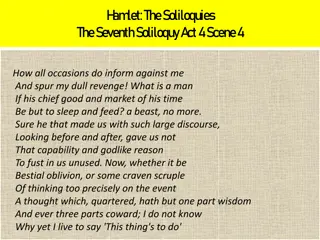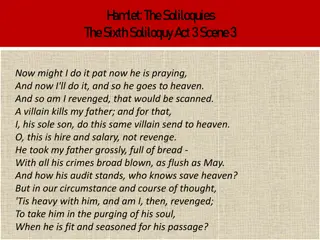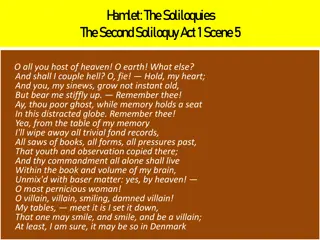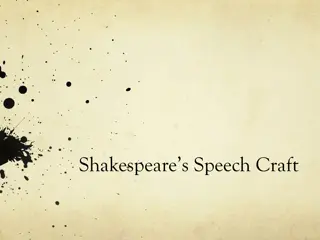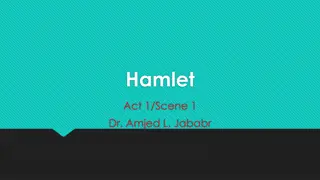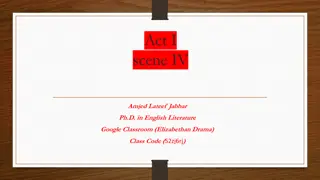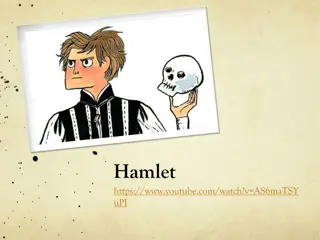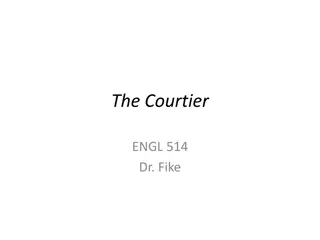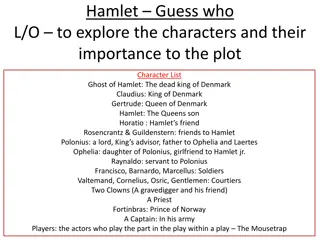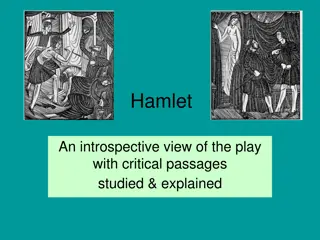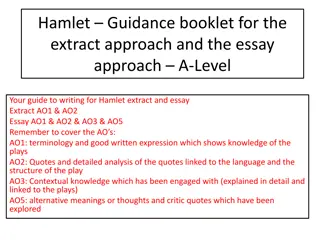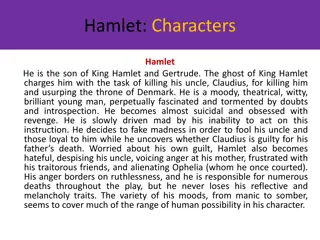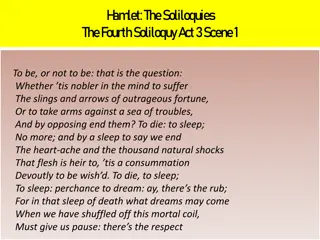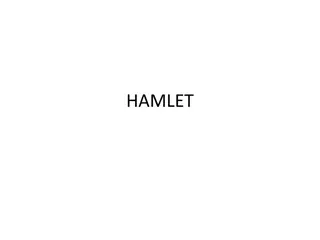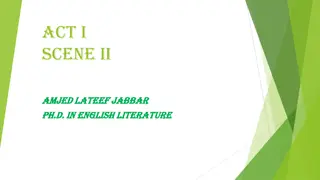Exploring Hamlet's Interiority and Individual Identity
Delve into the complex themes of interiority, individual identity, and consciousness in Shakespeare's "Hamlet." Follow Hamlet's journey as he grapples with the idea of self, memory, and existence, challenging traditional notions of identity and embracing a modern sense of subjectivity. Analyze key soliloquies and interactions to unravel Hamlet's inner struggles and his pursuit of authenticity.
Download Presentation

Please find below an Image/Link to download the presentation.
The content on the website is provided AS IS for your information and personal use only. It may not be sold, licensed, or shared on other websites without obtaining consent from the author. Download presentation by click this link. If you encounter any issues during the download, it is possible that the publisher has removed the file from their server.
E N D
Presentation Transcript
Hamlet: Getting Inside the Between: Interiority
The Birth of Interiority: Hamlet as transition toward a modern notion of consciousness or subjectivity as interiority. From the opening, Hamlet stands apart as spokesman for an authentic individual identity: Film clip of Hamlet s first appearance and soliloquy (Olivier, 13:15 18:52), 1.2.61-158; pp. 12-15. Hamlet rejects identity as something that is exterior, like clothes, that can be put on and taken off: Seems, madam? Nay, it is. I know not "seems." . . . I have that within which passes show; These but the trappings and the suits of woe. (1.2.76, 85-86) Hamlet proposes identity as unique, interior, and continuous.
Individuality, Continuity, and the Specter of Suicide: The repeated word in Hamlet's initial exchange with Gertrude and Claudius is "common. if Hamlet agrees that death is common, he denies his own individual identity. Hamlet thus must hold on to the memory of his father in the past in order to maintain his own sense of individual identity in the present.
Hamlet's First Soliloquy pp.14-15; 1.2.129-159 Hamlet s lament that his mother has failed properly to remember the past--his dead father--necessarily takes the form of an urge to terminate his self in the present.
But there is an editoral dispute over this first soliloquy: Quarto 2 (1604) reads O that this too too sallied [sullied] flesh would melt / Thaw, and resolve itself into a dew. The Folio (1623) reads O that this too too solid flesh would melt / Thaw, and resolve itself into a dew. Which do you think is the best editorial choice? A) sallied ? or B) solid ?
The Ghost of a Self: Hamlet's second long soliloquy: The idea of remembering his idealized father resurfaces in response to the ghost's commandment for revenge: p. 31;1.5.92 - 112 Film Clip of Olivier s Second Soliloquy, 37:38 - 41:36
Hamlet's Second Soliloquy, p. 31; 1.5.92-112: The ghost s parting line before Hamlet s soliloquy is: Adieu, adieu, adieu. Remember me. Could someone come up and write out on the board a possible rendering/meaning of the three repeated words that begin this line?
If Hamlet wipes out the tables of his past, what is he wiping out? A) His Danish history B) His humanist education at Wittenberg C) His diaries about himself D) His reliance upon food E) His mathematical calculations
Hamlet's Second Soliloquy, In Sum: Here, Hamlet s past ideal rushes into his present and defines his future for him. But the irony is that the ghost's demand for revenge itself requires a kind of suicide. Hamlet must collapse his identity into the standard mold of the revenge hero: a figure that is absolute and extreme and everything opposed to a Christian courtier (molded by his humanist education at Wittenberg) see Ur-Hamlet (1580s) source for the play, probably by Thomas Kyd, author of the popular revenge tragedy, The Spanish Tragedy (c. 1587)
Hamlets Age Hamlet, in response to the ghost s commandment, says my sinews, grow not instant old. How old is Hamlet? A) 18-21 B) 25 C) 30 D) 35 E) We don t know for sure
More Delaying, and Delaying, and Delaying Hamlet does not immediately erase his youthful self, grow instant old, and carry out his revenge in remembrance of his father; he delays. and in Act 3, scene 1, the idea of suicide resurfaces in his famous "To be or not to be" soliloquy.
The View from Inside: The (K)not of Being (pp. 63-64; 3.1.56-89) This speech "To be or to be" is itself a delaying speech. Two Versions: 1) FILM CLIP from ETHAN HAWKE PRODUCTION, Almerayda director (2000 New York) 29:45 - 30:53; 33:09 33:48; 40:10 42:36 2) FILM CLIP from KENNETH BRANAGH PRODUCTION (19th century-type world); 1:32:20 1:36:44 Which did you like best? A. Hawke B. Branagh
Which of the following in ll. 56-68 of this speech do not connote the idea of both being and not being? A) suffer / The slings and arrows of outrageous fortune B) end C) consummation D) sleep E) shuffled off this mortal coil
Hamlets Conclusion "Thus conscience does make cowards of us all." What does conscience here mean? A) Consciousness or thinking B) Wakefulness C) Moral awareness D) A and B E) A and C
The Problem The problem is that for Hamlet acting responsibly involves sorting out both sides of his inner being--the avenger and the humanist--yet the very process of sorting them out mixes them. That is the very problematic K(not) of his inner Being.
This is K(not) the end! Katie Adkison next lecture on women in the play.
